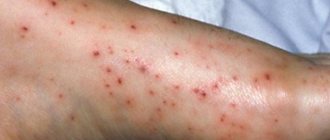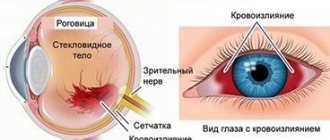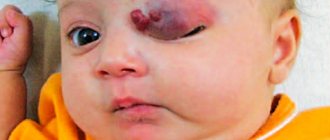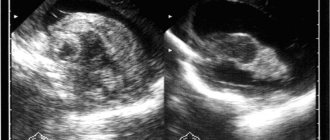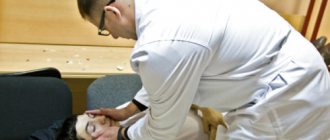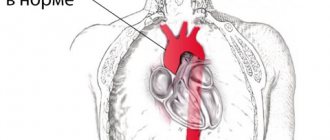What are small hemorrhages on the skin?
Hemorrhage under the skin occurs when capillaries rupture. Due to the small amount of blood in the thinnest vessels, the spots will be within millimeters in size. Usually there is a single localization of such points. A person does not feel a deterioration in health, and may not even be aware of the presence of petechiae on the skin.
To understand that a skin rash is damage to the capillaries, and not an allergy, it is enough to press on that place - the spots do not change color and do not disappear. After some time, the formations will lighten and then disappear.
Why blood vessels burst in the legs: reasons
Fragility of capillaries and small veins can be caused by endogenous (internal) and exogenous (external) factors. In the first case, we are talking about the following reasons:
- Phlebeurysm. Disruption of the valvular apparatus of the veins leads to a change in blood flow: the diameter of the veins increases, they become more tortuous, and their walls become thinner. As a result, there is an increase in the severity of the vascular network, the person complains of a feeling of heaviness and fullness in the lower extremities, swelling and cramps appear. In the later stages of the development of the disease, a violation of the trophism of soft tissues is possible, accompanied by the appearance of dark spots and difficult-to-heal ulcers on the skin.
Expert opinion
One of the first symptoms of varicose veins is the appearance of telangiectasias on the lower extremities - vascular “stars” and “webs” of a reddish, purple or bluish color. If telangiectasias occur, it is recommended to consult a phlebologist and, if necessary, begin treatment. Since they appear at a very early stage of varicose veins, these changes usually respond well to conservative treatment. However, if taking venotonics does not give the desired result, it is possible to remove telangiectasia using minimally invasive surgical methods - for example, laser coagulation or sclerotherapy.
Vascular surgeon, phlebologist
Osipova Ekaterina Yakovlevna
- Endocrine disorders. This primarily concerns diabetes mellitus: if the disease is not treated, diet is not followed, lifestyle changes and blood sugar levels are controlled, diabetes can lead to a number of serious complications, one of which is vascular disorders. In particular, this applies to peripheral capillaries and veins: with diabetes, veins often burst and bruises form on the legs, tissue trophism is disrupted, and poorly healing ulcers can occur.
- Cardiovascular diseases. Any pathology affecting the heart, large veins and arteries automatically affects the condition of small peripheral vessels.
- Pregnancy and lactation. The appearance of spots and bruises on the lower extremities, strengthening of the vascular network, increased capillary fragility - all these are quite common phenomena that accompany the period of bearing a baby and breastfeeding. Most often, their occurrence is triggered by changes in the hormonal balance of a woman’s body, as well as an increase in her body weight.
- Systemic lupus erythematosus. This autoimmune disease is characterized by damage to the microvasculature.
- Hormone replacement therapy and oral contraceptives. Estrogen-containing drugs provoke a decrease in the elasticity of veins and capillaries, increase blood clotting and slow down the speed of blood flow. This is one of the reasons why blood vessels in the legs burst more often in women than in men.
- Taking anticoagulants. One of the complications of therapy using blood thinning drugs is increased fragility of capillaries and small veins. As a result of this, blood vessels burst on the patient’s body (in particular on the lower extremities) and bruises appear.
Expert opinion
If you are taking warfarin, an indirect anticoagulant that blocks blood clotting factors, you need to have your blood tested regularly (about once a month). The results of the study make it possible to quickly change the dose of the drug to prevent the appearance of bruises, subcutaneous hemorrhages and bleeding.
Vascular surgeon, phlebologist
Osipova Ekaterina Yakovlevna
- Allergic reactions. One of the symptoms of allergies is redness of the skin due to the expansion of capillaries and increased permeability of their walls. In particular, their fragility increases - most often the vessels burst on the lower extremities, chest, back and face.
- Smoking and alcohol abuse. Alcohol and nicotine cause an increase in heart rate, increased blood pressure, the release of adrenaline into the blood, provoke blood thickening and impede blood flow. Due to this, the load on the veins gradually increases, leading to their deformation and fragility.
- Overweight and obesity. The higher a person’s body weight, the greater the load placed on the lower limbs. In addition, overweight people are more likely to have hypertension, which causes a decrease in the elasticity of blood vessels.
- Unbalanced nutrition, hypo- and avitaminosis. Insufficient intake of magnesium, potassium, Omega-3 and Omega-6 fatty acids, ascorbic acid, B vitamins, coenzyme Q10 and other substances necessary for the normal functioning of the cardiovascular system leads to fragility of veins and capillaries.
- Elderly age. As the body ages, the permeability of capillary walls may increase, and their elasticity may decrease. This leads to small blood vessels in the lower extremities often bursting in older men and women.
Vessels burst in the legs: causes
Vessels in the legs and arms can burst due to the following exogenous factors:
- Injuries. Bruises, compression, abrasions and other mechanical damage provoke a violation of the integrity of capillaries and veins.
- Exposure to ultraviolet radiation. Prolonged exposure to direct sunlight or in a solarium leads to vasodilation, provoking the development of ultraviolet erythema - a hyperemic, painful and swollen area of the skin. In addition, prolonged UV exposure is accompanied by loss of fluid from the body, which makes the blood thicker and more prone to blood clots.
- Excessive or insufficient physical activity. If a person leads a sedentary lifestyle and moves little, any physical activity is stressful for the body. This also applies to stress on the lower extremities - with prolonged walking, running or standing, the vessels of the lower extremities of an untrained person can expand and burst. The same applies to excessive physical activity in trained athletes.
- Mechanical impact during cosmetic procedures. Acid and mechanical peels, massage, laser hair removal, sugaring, waxing - all this can negatively affect the condition of the vessels of the lower extremities, especially in the presence of concomitant pathologies (for example, varicose veins, diabetes, cardiovascular diseases, etc.)
The most common reason for the appearance
The most common cause of hemorrhage is trauma to the skin and soft tissues.
Petechiae appear due to:
- soft tissue damage;
- pressing on clothing and its elements (straps, belts);
- rubbing the surface of the skin.
This creates high pressure, and the walls of the capillaries burst, releasing blood, which then spreads under the skin. This condition can also be caused by emotional stress, during crying or screaming. With age, all tissues of the body become less durable, so the occurrence of petechiae becomes more frequent.
Treatment
Modern treatment for the appearance of blue spots and formations of the lower extremities is complex. It involves the use of conservative therapy or surgical intervention, the choice of which is made after the causes of the pathological process have been diagnosed. Conservative therapy includes the use of various medications that improve the functional state of hemostasis, as well as the strength of the walls of venous vessels and microcirculatory structures. Surgical treatment is carried out to remove vessels with irreversible changes in their walls.
If blue spots appear systematically for no apparent reason, you should consult a phlebologist (a medical specialist who deals with the problems of vein diseases), who will prescribe additional research and appropriate treatment.
What diseases provoke petechiae?
Blood diseases, such as leukemia and aplastic anemia, change its composition, in particular, reduce the formation of platelets. With low blood clotting and weak blood vessels, hemorrhage occurs and wounds take longer to heal. Petechiae can appear against the background of other diseases of the blood and organs involved in hematopoiesis.
Another cause of vascular disease can be autoimmune diseases. The immune system, for unknown reasons, begins to wage an imaginary fight against the cells of its own body. With a prolonged immune attack, inflammation begins, which destroys blood vessels.
Petechiae can occur as a result of:
- spondyloarthritis;
- hemorrhagic vasculitis;
- systemic lupus erythematosus;
- scleroderma.
Also, temporarily, hemorrhage may appear when:
- sore throat;
- cytomagalovirus infection;
- mononucleosis;
- scarlet fever;
- endocarditis;
- enterovirus infection.
Deficiency of vitamins C and K leads to petechial rashes under the skin. Then bruising occurs in small quantities. Over time, as the body recovers from illness and the level of nutrients in the foods consumed increases, the appearance of petechiae decreases.
The condition is considered dangerous when the patient notices a rash on the body, in combination with other symptoms:
- Increased body temperature.
- Pain when turning the head.
- Headache.
- Difficulties with coordination.
- Muscle pain.
- Foggy consciousness.
- Pain in small or large joints.
- Digestive system disorder.
- Bleeding wounds, gums.
- Bruises on the body.
Bleeding under the skin should not frighten a person if it appears infrequently, in small quantities, and there are no other signs of serious illness. Otherwise, it is recommended to undergo examination at a medical facility.
ONLINE REGISTRATION at the DIANA clinic
You can make an appointment by calling the toll-free phone number 8-800-707-15-60 or filling out the contact form. In this case, we will contact you ourselves.
If you find an error, please select a piece of text and press Ctrl+Enter
Why do bruises appear on the legs?
A blue-violet spot on the skin of the lower extremities is the result of hemorrhage in the tissue or pathological expansion of the lumen of the venous vessels with stagnation of blood. Hemorrhage usually develops after bruising the tissues of the lower extremities due to a direct blow from an object or a person falling. Bruises on the legs for no reason appear due to the development of various pathological processes, which include:
- Varicose veins, which may be the result of a hereditary predisposition, blood stagnation, or a decrease in the strength of the walls of blood vessels due to a violation of their nutrition, an inflammatory reaction.
- A pronounced decrease in the strength of the walls of microcirculatory structures with insufficient intake of vitamin C, as well as some protein compounds from food.
- Violation of the functional activity of the blood coagulation system (hemostasis), in which the process of thrombus formation worsens to prevent the development of bleeding. This is possible with prolonged fasting of a person, liver failure (liver cells, hepatocytes, synthesize factors that are directly involved in blood clotting, as well as the formation of a blood clot), pathology of the blood system, and red bone marrow.
- Bruises on the legs of women are often a consequence of changes in the body's hormonal levels.
Normally, women may experience bruises on their legs after pregnancy and childbirth, which is caused by changes in the levels of various hormones, as well as congestion in the lower extremities associated with compression of the main vessels of the pelvic cavity by the enlarged uterus.
32nd city clinical clinic
The appearance of bruises on the body from a blow, injury or strong pressure is a common occurrence in life. At the site of injury, capillaries rupture and blood seeps into the surrounding tissue layer, forming a bruise. But if bruises appear “on their own,” then their appearance is the first signal to think about your health. The cause of their occurrence can be either a minor or a fairly serious disease.
Seemingly unreasonable bruises on the body can signal the possible presence of diseases such as hemorrhagic vasculitis, varicose veins, vascular fragility, impaired blood circulation, decreased blood clotting and a lack of platelets. Bruises can appear due to hormonal imbalances and long-term use of medications such as antidepressants, analgesics, anti-inflammatory and anti-asthmatic drugs. This is due to their ability to reduce blood clotting, which subsequently leads to bruising. In addition, bruises on the body can appear due to diseases of the circulatory system, hypertension, rheumatism, liver diseases, or after recent infectious diseases.
It should also be noted that the occurrence of bruises on the body for no reason often indicates a lack of vitamins C, K and P in the human body. Due to their insufficient content, the process of producing collagen, a protein that protects the walls of capillaries from rupture and cracks, is disrupted. With a lack of collagen, blood vessels become weak and fragile, and as a result, bruises appear on the body.
This problem cannot be ignored. Under no circumstances should you resort to self-medication. To identify the cause of the appearance of “unreasonable bruises” on the body, you need to see a general practitioner. Only a doctor can identify the cause of bruises and prescribe the necessary examinations and treatment.
The most important thing in every person’s life is his health! After all, if the body signals about any disease in the form of bruises, you should not take it lightly. A timely diagnosis at the earliest stage of the disease is the key to successful treatment!
Material prepared by: Zhanna Stanislavlna Kevra – local therapist (head of the therapeutic department)
